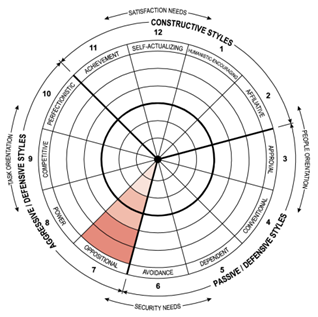In a previous blog, we introduced the Human Synergistics Circumplex™, a proven framework to measure, report, discuss and better understand individual and collective human behaviour, and their impact upon business and organisational performance (refer: Catching Smoke: A Proven Framework for Addressing Culture and Leadership).
Today’s blog focuses on one of the Aggressive/Defensive styles – Oppositional: what it is, how it can hinder your personal effectiveness and/or the performance of your business/organisation and how you can reduce any personal oppositional tendencies, or those which might exist in the culture of your workplace.

So Just What is the Oppositional Style?
Whether we’re looking at it from an individual leadership or broader workplace culture perspective, primary characteristics of the Oppositional style include pointing out flaws, resisting change and not easily accepting criticism.
Leaders high in the Oppositional style will tend to, for example:
- ask tough, probing questions, consistently and almost out of habit
- seem aloof, detached from others
- be overly negative, cynical, sarcastic, and
- look for, and work hard to find, flaws in the ideas and opinions of others (often as a means to building their own status).
Workplace cultures can themselves become Oppositional in nature, in which is becomes “the done thing” for participants to, for example:
- oppose new ideas
- be hard to impress
- question decisions, and
- resist criticism.
So Why Should I be Concerned?
Research over several decades by Human-Synergistics has consistently shown that workplaces high in the Oppositional style (and other Defensive styles) are significantly less effective than workplaces with predominantly Constructive cultures.
Indeed, primarily constructive workplaces:
- are 32% more able to effectively respond to changes in the external environment
- achieve 32% higher quality performance
- demonstrate 28% more effective teamwork
- have a 25% greater commitment to producing a quality result
- have individuals that are 32% more motivated, 26% more satisfied and 25% more likely to stay with the organisation.
Individual leaders engaged in highly Oppositional thinking and behaviour tend to find it difficult to build and maintain the constructive relationships necessary to achieving longer-term success. Workplace cultures high in Oppositional behaviours tend to:
- be frequently “bogged down” in conflict
- be unable to identify and implement the changes necessary for future success
- be confusing places in which to work (messages/expectations are often inconsistent as management is often not cohesive/singular in focus)
- result in an “us and them” structure in which management makes the decisions and workers “just do what they’re told”
- not utilise the existing talents of their people, and not nurture/foster new talent, and, perhaps not surprisingly,
- have higher staff turnover and lower rates of engagement/satisfaction.
OK, So How Can We Minimise Oppositional Tendencies?
If you’ve read this far and come to the conclusion that your own performance, and/or that of your business/organisation may be hindered by an overdose of Oppositional thinking and/or behaviour, there are some things you can you do to reduce its presence and get back on track.
At an individual leadership level, for example:
- resist your natural urge to jump in and find problems – at least hear the person out, acknowledge, value and consider their idea of opinion even if you can’t accept it for some reason
- acknowledge that far from admiring your ability to point out flaws/potential problems, others may in fact see you as an obstacle
- make more of an effort to connect with people at a personal level, and to be more approachable
- personally embrace, support, promote and recognise a good idea from someone else (ensuring that you give them due credit of course!), and
- praise in public, criticise in private (and ensure your criticism is as constructive/positive as possible).
At a collective/workplace level, try:
- implementing strategies to actively seek out the ideas and opinions of others (if oppositional behaviours have been present for a while, you may find people initially reluctant, but you will need to persist in order to facilitate change)
- making a point to overtly recognise and celebrate individual and collective success
- discussing the need for a culture shift with your fellow leaders/managers in the business, and ensuring that there is a consistent example for others to follow, and
- ensuring that your structures, systems and processes encourage people and units to work constructively together rather than remain in silos and/or compete with one another.
In future blogs, we’ll continue to look at the what, why and how of other workplace culture and personal leadership styles. In the meantime, be sure to call if you’d like to explore the range of culture and leadership programs we have available to help transform your people, your team and your business/organisation.
If you’ve missed previous blogs in this series, be sure to search for the “Focus on Culture and Leadership” series of articles.

